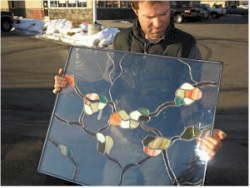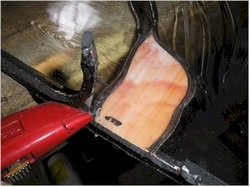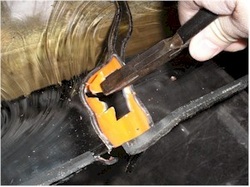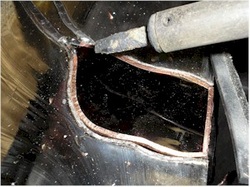How To Repair An Insulated Stained Glass Window
need a video of article

Here's the finished window we delivered. The clients didn't care for some of the colors that they had chosen. We just can't let someone have a piece of glass that they don't love!

They had sent us a picture of a window. They wanted us to design a window that would be similar (identical). The wife picked out and approved the colors. The husband was more particular..why didn't he pick out the colors?

To repair an insulated unit, you've first got to cut the butyl rubber gasket on both sides of the art glass. Start with a very sharp utility knife. I like to pull against the strip on the work bench. It takes a great deal of effort to split the rubber. But once both sides are split the unit will open like a book.

The only piece to be repaired that intersected an edge of the panel was an orange piece of glass. To peel the rubber away, the utility knife was effective. First I peeled back the top piece of rubber, using care so that it would be intact later when I put it back.
I also cut and peeled back the bottom piece and the piece that was left on the edge of the glass.
I also cut and peeled back the bottom piece and the piece that was left on the edge of the glass.

The three strips of rubber were peeled back so they wouldn't be in the way.

Then I scored the glass to be removed many times and began tapping underneath to remove pieces.

Then I used pliers to remove most of the glass. At this step, one should use care not to damage the foil. It's time well spent because repairing the old foil is tedious and more difficult than keeping the old foil intact.

Then a hot iron is used to melt away the solder holding the glass in place.

With pliers, I hold the foil to be removed, and slide the iron carefully between the foil that held the broken out piece and the pieces that are to remain.

Then the new glass is cut out.

And the glass is ground to fit.

Then the new piece is fit to the opening and trimmed just a bit till it fits perfectly.

And the foiled glass is tacked in place.

Once the soldered piece is complete, the rubber strips are eased into place.

After the first leaf is replaced, I moved to the next cluster of pieces to be replaced. I felt it important to replace one section at a time so that the window wasn't weakened too much.

The pieces were removed just as those before.

A small piece of glass was laid under the replacement pieces to boost them up to the proper height while they were soldered (you can see it peeking out under the brown leaf).

When all the pieces were replaced, and soldered in, the window was flipped over and soldered on the back.

Jeanne scrubbed the window with CJ's flux and patina remover, then patina'd the lead lines as they had been before the repairs were made. Then she polished and polished to remove every smudge.

Meanwhile, I polished the inside surface of each of the pieces of tempered glass.

Once it was all clean, I was able to place the tempered glass onto the art glass.

I had to reseal the rubber gasket using butyl rubber from a tube.
Here's the finished panel, much the same as when we started, just some different colors. "Bad Photo!" sorry

Lily Havey, one of our favorite retired stained glass artists, wrote with a concern after this article was published: "I was under the impression that once you broke the seal on an insulated panel all the dead air space was replaced by air so that it became useless as insulation. "
My Answer: That's true, and then you stick it back together and you have dead air space again. The butyl rubber stays quite sticky and if you replace the glass very soon, the rubber that's left on the art glass bonds back together with that on the tempered glass. If it's no longer sticky, you can add a thin film of bonding agent available at Home remodeling centers in the roofing department. We use "Henry 209 Elastomastic" because it bonds with butyl and it's black like the rubber. I've been told that silicone shouldn't be used because it tries to dissolve butyl rubber.
They used to put Argon in between windows but found that over time (5 years) the air gasses migrate through the molecules of the glass so the slight insulative advantage of argon is lost and isn't worth the extra expense.
My Answer: That's true, and then you stick it back together and you have dead air space again. The butyl rubber stays quite sticky and if you replace the glass very soon, the rubber that's left on the art glass bonds back together with that on the tempered glass. If it's no longer sticky, you can add a thin film of bonding agent available at Home remodeling centers in the roofing department. We use "Henry 209 Elastomastic" because it bonds with butyl and it's black like the rubber. I've been told that silicone shouldn't be used because it tries to dissolve butyl rubber.
They used to put Argon in between windows but found that over time (5 years) the air gasses migrate through the molecules of the glass so the slight insulative advantage of argon is lost and isn't worth the extra expense.



